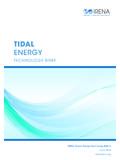Transcription of FUTURE OF WIND - IRENA
1 FUTURE OF WINDD eployment, investment, technology, grid integration and socio-economic aspectsA Global Energy Transformation paper IRENA 2019 Unless otherwise stated, material in this publication may be freely used, shared, copied, reproduced, printed and/or stored, provided that appropriate acknowledgement is given of IRENA as the source and copyright holder. Material in this publication that is attributed to third parties may be subject to separate terms of use and restrictions, and appropriate permissions from these third parties may need to be secured before any use of such 978-92-9260-155-3 Citation IRENA (2019), FUTURE of wind : Deployment, investment, technology, grid integration and socio-economic aspects (A Global Energy Transformation paper), International Renewable Energy Agency, Abu document presents additional findings from Global Energy Transformation.
2 A roadmap to 2050 (2019 edition) available for download from For further information or to provide feedback, please contact IRENA at IRENAThe International Renewable Energy Agency ( IRENA ) is an intergovernmental organisation that serves as the principal platform for co-operation, a centre of excellence, a repository of policy, technology, resource and financial knowledge, and a driver of action on the ground to advance the transformation of the global energy system. IRENA promotes the widespread adoption and sustainable use of all forms of renewable energy, including bioenergy, geothermal, hydropower, ocean, solar and wind energy, in the pursuit of sustainable development, energy access, energy security and low-carbon economic growth and report benefited from input and review of the following experts: Elbia Gannoum and Selma Bellini (ABEE lica Brazil wind Energy Association), Kaare Sandholt (China National Renewable Energy Centre), Qin Haiyan and Yu Guiyong (Chinese wind Energy Association), Lucy Craig, Jeremy Parkes and Vineet Parkhe (DNV GL Energy), Xue Han (Energy Research Institute of China), Karin Ohlenforst and Feng Zhao (Global wind Energy Council), Laura Cozzi and Alberto Toril (International Energy Agency), Karsten Capion (Klimaraadet The Danish Council on Climate Change), Kihwan Kim (Korea Energy Economics Institute), K.
3 Balaraman (National Institute of wind Energy India), Jeffrey Logan and Mai Trieu (National Renewable Energy Laboratory), Yuan Jiahai (North China Electric Power University), Aled Moses, yvind Vessia and Sune Str m ( rsted), Ntombifuthi Ntuli (South African wind Energy Association), Yasushi Ninomiya (The Institute of Energy Economics, Japan), Rina Bohle Zeller (Vestas wind Systems A/S), Ivan Komusanac (WindEurope) and Stefan Gs nger (World wind Energy Association). Valuable review and feedback were provided by IRENA colleagues: Francisco Boshell, Yong Chen, Rafael De S Ferreira, Celia Garc a-Ba os, Rabia Ferroukhi, Gurbuz Gonul, Carlos Guadarrama, Diala Hawila, Seungwoo Kang, Rodrigo Leme, Paul Komor, Neil MacDonald, Julien Marquant, Thomas Nikolakakis, Bishal Parajuli and Michael Taylor. The editor of this report was Lisa authors: This report was developed under the guidance of Dolf Gielen and Ricardo Gorini and authored by Gayathri Prakash and Harold Anuta, with additional contributions and support from Nicholas Wagner and Giacomo Gallina.
4 IRENA is grateful for the generous support of the Federal Ministry for Economic Affairs and Energy of Germany, which made the publication of this report a publication and the material herein are provided as is . All reasonable precautions have been taken by IRENA to verify the reliability of the material in this publication. However, neither IRENA nor any of its officials, agents, data or other third-party content providers provides a warranty of any kind, either expressed or implied, and they accept no responsibility or liability for any consequence of use of the publication or material herein. The information contained herein does not necessarily represent the views of the Members of IRENA . The mention of specific companies or certain projects or products does not imply that they are endorsed or recommended by IRENA in preference to others of a similar nature that are not mentioned. The designations employed, and the presentation of material herein, do not imply the expression of any opinion on the part of IRENA concerning the legal status of any region, country, territory, city or area or of its authorities, or concerning the delimitation of frontiers or 4 TAB LE S 7 ABBREVIATIONS 8 EXECUTIVE SUMMARY 91 ENERGY TRANSFORMATION PATHWAYS AND wind ENERGY Pathways for the Global Energy Transformation The Energy Transformation: Rationale Global Energy Transformation.
5 The role of wind energy 172 THE EVOLUTION AND FUTURE OF wind MARKETS Evolution of the wind industry Onshore wind outlook to 2050 Offshore wind outlook to 2050 423 TECHNOLOGICAL SOLUTIONS AND INNOVATIONS TO INTEGRATE RISING SHARES OF wind POWER GENERATION 624 SUPPLY SIDE AND MARKET EXPANSION Current status of wind supply industry 675 SOCIO-ECONOMIC AND OTHER BENEFITS OF wind ENERGY IN THE CONTEXT OF ENERGY TRANSFORMATION wind sector employment and local value chain Clustering with other low-carbon technologies: Hybrid systems 746 ACCELERATING wind POWER DEPLOYMENT: EXISTING BARRIERS AND SOLUTIONS 75 REFERENCES 83 CONTENTS3 FIGURESF igure ES 1. wind roadmap to 2050: tracking progress of key wind energy indicators to achieve the global energy transformation. 12 Figure 1: Pressing needs and attractive opportunities are driving the transformation of the world's energy system 16 Figure 2.
6 Renewables and efficiency measures, boosted by substantial electrification, can provide over 90% of necessary CO emission reductions by 2050. 17 Figure 3. wind would be the largest generating source, supplying more than one-third of total electricity generation needs by 2050 19 Figure 4. Comparison of scenarios for the global energy transition, with a focus on wind power generation. 20 Figure 5. wind power would contribute to Gt of CO emissions reductions in 2050, representing 27% of the overall emissions reductions needed to meet Paris climate goals. 21 Figure 6: Overview of key milestones achieved by the wind industry so far since 1982. 23 Figure 7: Onshore wind cumulative installed capacity would grow more than three-fold by 2030 and nearly ten-fold by 2050 relative to 2018 levels. 25 Figure 8: Asia would continue to dominate global onshore wind power installations by 2050, followed by North America and Europe.
7 27 Figure 9: Global onshore wind power additions would need to grow more than three-fold by 2030 and more than five-fold by 2050 relative to 2018 levels. 28 Figure 10: Total installed cost of onshore wind projects have fallen rapidly and is expected to decline further by 2050. 33 Figure 11: Total Installed cost ranges and weighted averages for onshore wind projects dropped in many country/region since 2010. 34 Figure 12: The global weighted average capacity factor for new turbines has increased from 27% in 2010 to 34% in 2018 and would increase substantially in next three decades. 35 Figure 13: Regional weighted average LCOE and ranges for onshore wind in 2010 and 2018. 35 Figure 14: The Levelised cost of Electricity for onshore wind is already competitive now compared to all fossil fuel generation sources and would be fully competitive in a few years. 364 Figure 15: LCOE and global weighted average values for onshore wind projects, 2010 2020.
8 37 Figure 16: Scaling up onshore wind energy investment is key to accelerate the pace of global onshore wind installations over the coming decades. 38 Figure 17: total investments in global onshore annual wind power deployment, including new capacity installations and replacement of end-of-lifetime capacities. 39 Figure 18: Ongoing innovations and technology enhancements towards larger-capacity turbines, increased hub heights and rotor diameters would improve energy yields and reduce capital and operation costs per unit installed capacity. 40 Figure 19: Offshore wind power deployment to grow gradually to nearly 1 000 GW of total installed capacity by 2050. 43 Figure 20: Asia would dominate global offshore wind power installations by 2050, followed by Europe and North America. 44 Figure 21: Annual offshore wind capacity additions would need to scale up more than six-fold to 28 GW in 2030 and almost ten-fold to 45 GW in 2050 from GW added in 2018.
9 45 Figure 22: The global weighted average installed costs for offshore wind have declined by a modest 5% since 2010 and would decline greatly in the next three decades. 47 Figure 23: The global weighted average capacity factor for offshore wind has increased 8 percentage points since 2010, to 43%, and upcoming projects would have capacity factors up to higher range of 58% in 2030 and 60% in 2050. 49 Figure 24: By 2050, the LCOE of offshore wind would be competitive, reaching lower fossil fuel ranges. 50 Figure 25: LCOE and global weighted average values for offshore wind projects, 2010 2025. 51 Figure 26: Global offshore annual wind power deployment total investments including new capacity installations and replacements of end-of-lifetime capacities. 52 Figure 27: Investments would need to be shifted to emerging offshore wind markets such as Asia and North America followed by stable investments needed in Europe.
10 53 Figure 28: Anticipated timing and importance of innovations in offshore wind technology. 555 Figure 29: The average size of offshore wind turbines grew by a factor of in less than two decades and is expected to grow to output capacity of 15 20 MW by 2030. 56 Figure 30: Offshore Coastal wind power: potential of floating offshore wind power zoom in China 57 Figure 31: Offshore wind turbine foundation technologies. 58 Figure 32: Higher shares of wind power would be integrated in various G20 countries by 2050 63 Figure 33: Additional investments are required in grids, generation adequacy and some flexibility measures (such as storage) across the entire electricity system to integrate raising shares of variable renewable sources. 64 Figure 34: Power system flexibility enablers in the energy sector. 65 Figure 35: The Four dimensions of innovation. 66 Figure 36: In 2018, Vestas remained as the world s largest wind turbine supplier followed by Goldwind and Siemens-gamesa.










